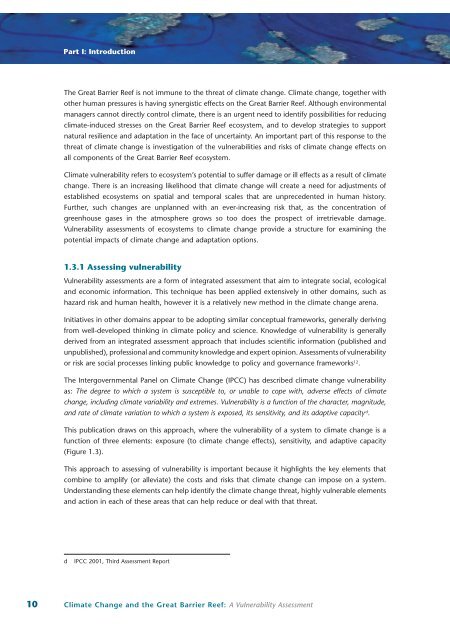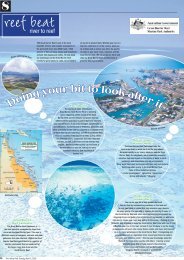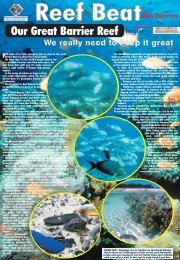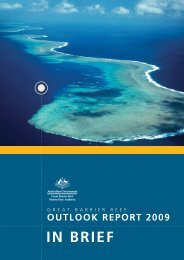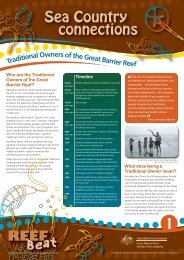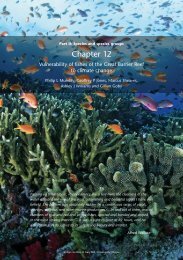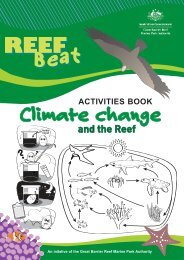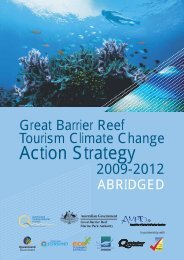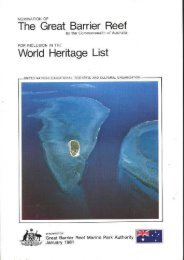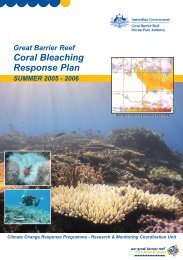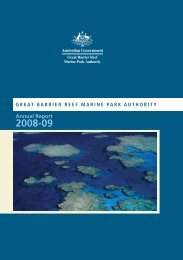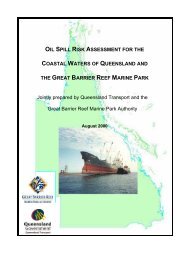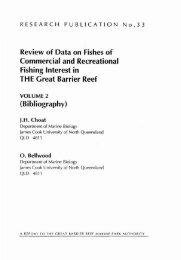Chapter 1: Introduction to the Great Barrier Reef and climate change
Chapter 1: Introduction to the Great Barrier Reef and climate change
Chapter 1: Introduction to the Great Barrier Reef and climate change
Create successful ePaper yourself
Turn your PDF publications into a flip-book with our unique Google optimized e-Paper software.
Part I: <strong>Introduction</strong><br />
The <strong>Great</strong> <strong>Barrier</strong> <strong>Reef</strong> is not immune <strong>to</strong> <strong>the</strong> threat of <strong>climate</strong> <strong>change</strong>. Climate <strong>change</strong>, <strong>to</strong>ge<strong>the</strong>r with<br />
o<strong>the</strong>r human pressures is having synergistic effects on <strong>the</strong> <strong>Great</strong> <strong>Barrier</strong> <strong>Reef</strong>. Although environmental<br />
managers cannot directly control <strong>climate</strong>, <strong>the</strong>re is an urgent need <strong>to</strong> identify possibilities for reducing<br />
<strong>climate</strong>-induced stresses on <strong>the</strong> <strong>Great</strong> <strong>Barrier</strong> <strong>Reef</strong> ecosystem, <strong>and</strong> <strong>to</strong> develop strategies <strong>to</strong> support<br />
natural resilience <strong>and</strong> adaptation in <strong>the</strong> face of uncertainty. An important part of this response <strong>to</strong> <strong>the</strong><br />
threat of <strong>climate</strong> <strong>change</strong> is investigation of <strong>the</strong> vulnerabilities <strong>and</strong> risks of <strong>climate</strong> <strong>change</strong> effects on<br />
all components of <strong>the</strong> <strong>Great</strong> <strong>Barrier</strong> <strong>Reef</strong> ecosystem.<br />
Climate vulnerability refers <strong>to</strong> ecosystem’s potential <strong>to</strong> suffer damage or ill effects as a result of <strong>climate</strong><br />
<strong>change</strong>. There is an increasing likelihood that <strong>climate</strong> <strong>change</strong> will create a need for adjustments of<br />
established ecosystems on spatial <strong>and</strong> temporal scales that are unprecedented in human his<strong>to</strong>ry.<br />
Fur<strong>the</strong>r, such <strong>change</strong>s are unplanned with an ever-increasing risk that, as <strong>the</strong> concentration of<br />
greenhouse gases in <strong>the</strong> atmosphere grows so <strong>to</strong>o does <strong>the</strong> prospect of irretrievable damage.<br />
Vulnerability assessments of ecosystems <strong>to</strong> <strong>climate</strong> <strong>change</strong> provide a structure for examining <strong>the</strong><br />
potential impacts of <strong>climate</strong> <strong>change</strong> <strong>and</strong> adaptation options.<br />
1.3.1 Assessing vulnerability<br />
Vulnerability assessments are a form of integrated assessment that aim <strong>to</strong> integrate social, ecological<br />
<strong>and</strong> economic information. This technique has been applied extensively in o<strong>the</strong>r domains, such as<br />
hazard risk <strong>and</strong> human health, however it is a relatively new method in <strong>the</strong> <strong>climate</strong> <strong>change</strong> arena.<br />
Initiatives in o<strong>the</strong>r domains appear <strong>to</strong> be adopting similar conceptual frameworks, generally deriving<br />
from well-developed thinking in <strong>climate</strong> policy <strong>and</strong> science. Knowledge of vulnerability is generally<br />
derived from an integrated assessment approach that includes scientific information (published <strong>and</strong><br />
unpublished), professional <strong>and</strong> community knowledge <strong>and</strong> expert opinion. Assessments of vulnerability<br />
or risk are social processes linking public knowledge <strong>to</strong> policy <strong>and</strong> governance frameworks 12 .<br />
The Intergovernmental Panel on Climate Change (IPCC) has described <strong>climate</strong> <strong>change</strong> vulnerability<br />
as: The degree <strong>to</strong> which a system is susceptible <strong>to</strong>, or unable <strong>to</strong> cope with, adverse effects of <strong>climate</strong><br />
<strong>change</strong>, including <strong>climate</strong> variability <strong>and</strong> extremes. Vulnerability is a function of <strong>the</strong> character, magnitude,<br />
<strong>and</strong> rate of <strong>climate</strong> variation <strong>to</strong> which a system is exposed, its sensitivity, <strong>and</strong> its adaptive capacity .<br />
This publication draws on this approach, where <strong>the</strong> vulnerability of a system <strong>to</strong> <strong>climate</strong> <strong>change</strong> is a<br />
function of three elements: exposure (<strong>to</strong> <strong>climate</strong> <strong>change</strong> effects), sensitivity, <strong>and</strong> adaptive capacity<br />
(Figure 1.3).<br />
This approach <strong>to</strong> assessing of vulnerability is important because it highlights <strong>the</strong> key elements that<br />
combine <strong>to</strong> amplify (or alleviate) <strong>the</strong> costs <strong>and</strong> risks that <strong>climate</strong> <strong>change</strong> can impose on a system.<br />
Underst<strong>and</strong>ing <strong>the</strong>se elements can help identify <strong>the</strong> <strong>climate</strong> <strong>change</strong> threat, highly vulnerable elements<br />
<strong>and</strong> action in each of <strong>the</strong>se areas that can help reduce or deal with that threat.<br />
<br />
IPCC 2001, Third Assessment Report<br />
10 Climate Change <strong>and</strong> <strong>the</strong> <strong>Great</strong> <strong>Barrier</strong> <strong>Reef</strong>: A Vulnerability Assessment


